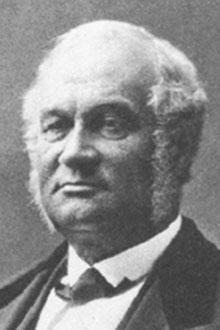- Home
- Archival Material
- College History Projects
- Subject-Based Digital Projects
Alexander Ramsey (1815-1903)

Alexander Ramsey was born near Harrisburg, Pennsylvania on September 8, 1815, the son of Thomas and Elizabeth Kelker Ramsey. He was educated locally and then attended Lafayette College in Easton, Pennsylvania. Entering the Law Department of Dickinson College in Carlisle, Pennsylvania in 1839, he earned a bachelor of laws degree in 1840. He was admitted to the Pennsylvania bar and opened a practice in Harrisburg.
At that time Ramsey began what can only be termed as a meteoric rise in politics, beginning with his appointment, almost immediately, as secretary to the electoral college of Pennsylvania, and then as clerk of the State house of representatives in 1841. By late 1842 he had been elected as a Whig to the Twenty-eighth Congress, representing Dauphin County, and served two terms from 1843 to 1847 before declining further nomination. Still only in his early thirties, his life took a momentous step when, on April 2nd, 1849, President Zachary Taylor appointed him to the post of Governor of the newly established Territory of Minnesota. Though some reports say that Ramsey would he preferred the more lucrative post of collector of tariffs at the Port of Philadelphia, he became and remained a Minnesotan for the rest of his life.
Governing the territory during a crucial four year period of its early history, he was removed from office by the new Democratic President Franklin Pierce in 1853. He practiced law and was president of the Baldwin School, now Macalester College, for two years. Then, Ramsey was elected as the second mayor of St. Paul in 1855. When statehood was achieved he failed to be elected governor in 1857 by a narrow margin, but achieved that success in 1860, serving through the first half of the Civil War as the state's second elected governor. He was notable at this time for his brutal response to an Sioux tribal raid on a settlement in Meeker County, Minnesota, in 1862. This saw him order the extermination or removal of the tribe from the state and supervise a culminating mass execution of thirty-eight Sioux prisoners. President Lincoln, in fact, intervened to prevent further executions.
He was elected in 1863 as a Republican to the United States Senate and served as such until 1875. Four years later Rutherford Hayes made Ramsey his Secretary of War, in which capacity he served until 1881. Soon after, he headed the Edmunds Commission in its dealings with the question of Mormonism and polygamy in Utah; he resigned in 1886 to retire to Minnesota. From 1849 to 1863 he served as president of the Minnesota Historical Society, and after an absence of nearly thirty years, he returned to that position in 1891 and served until his death. He was also a delegate to the centennial celebration of the adoption of the Constitution in 1887.
He had married Anna Earl Jenks on September 10th, 1845. The couple had two sons who died in infancy and one daughter. Alexander Ramsey died in St. Paul, Minnesota on April 22, 1903. He was eighty-seven years old. Ramsey County, Minnesota, of which St. Paul is the county seat, was named for him in 1849 as was Ramsey County, North Dakota in 1883.
Date of Post:
2005
College Relationship:
Alumnus/Alumna Class Year: